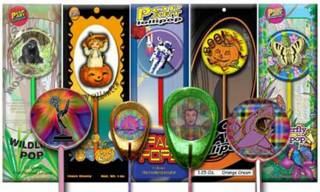Predictions for 2005, Part II
1. If Firefox gains momentum, we will see some new online advertising formats, driven in part by the browser's powerful popup (plus animations and flash) blocker and in part by some of the browser's emerging extensions, such as the one that allows users to annotate online text and share the notes with others.
2. In-game advertising will be "the next big thing" if the current players, inGamePartners and Massive, manage to avoid some dangerous pitfalls. If they do and if advertising becomes an important revenue stream for the publishers, new game genres and formats will evolve to accommodate advertisers' needs.
3. Secondary content filters will continue to rise in dominance. The saying used to be "if it's not in the evening news, it never happened". Now, it is "if it wasn't picked up by my aggregator, then it hasn't been published or aired and hence it never happened." Drudge, Google News and RSS aggregators will be joined by audio (iPodder) and video aggregators.
4. The radio landscape goes crazy. The rumour is iPod or a similar device will eventually add sattelite reception. The rise of podcasting is already being documented. The spread of WiFi will enable internet radio broadcasts to PDAs. The war between the three formats will be fun to watch.
5. Mobile video will finally happen. Some say it will be on cellphones, others bet on a video-enabled iPod. My bet: a portable Media Center device that lets you watch the stuff you DVRed the night before; the value is apparent and the piracy-related concerns are non-existent.
(oh, wait, isn't Zen Portable Media Player just that?)
6. On a related note, TiVo will have to do something to stay in the game: cut subscription fees, sell out, come up with new features, or start offering a mobile video device.
7. Real time is out, time delay is in when it comes to content distribution - DVRs and podcasting set the pace. The media space is "a la carte" and on demand.
8. We will see an even tighter integration of content and advertising, and not only on TV; new battlegrounds include computer and video games, blogs and RSS feeds, on-demand radio and video.
9. Context and search-related advertising will grow along with the amount and variety of digitalized content. Video, sound and print all become fully searchable.
10. The rewired retail space will offer some amazing opportunities for POP work. Some of the good things to come are RFID tags, smart shopping carts and digital shelftalkers, electronic paper.
Head-Mounted Display, Finally?

(UPDATE, January 20, '05: Launched.)
"In the next two weeks, Icuiti will announce its new Video Eyewear to the world." Oh, boy.
Is it the long-delayed beginning of the era of the truly portable video? It may as well be if the display
- Projects an image large and clear enough,
- Is compatible with a range of devices - PDAs, game consoles and handhelds, PCs, cell phones, DVD players and portable Media Centers,
- Has a long battery life...
- ...without a separate huge battery to lug around,
- Doesn't weigh a ton,
- Utilizes thin elegant cables,
- Does not appear excessively dorky,
- Fits into a purse,
- Costs within a $500 range.
Judging by the scarce pictures on the site's only page, the Icuiti's display seems to be all that.
Apparently, the gear is being tested on the Japanese mobile phone market since December 1 and is sold through the VisualWear site (Japanese). Some product info:
"Video Eyewear consists of a glasses-style display part and controller unit about the size of a pack of smokes. The glasses have on each side a 640×480 dot, 32 bit color display. The 3D glasses create a picture at a distance of 2 meters with a size of 42 inch. The HMD weighs only 70g. Display features 3D display capabilities and can represent 3D video from any standard parallax source. Video Eyewear is listed as Open Price, but the actual retail price is said to be less than 70,000 yen (~$680)." Sources: TechJapan, i4u
Compare to Eyetop DVD ($599), Mobile Personal Cinema Glasses ($449)
Predictions for 2005, Part I
10. The Internet Will Be Hot Again
This has certainly been a growth year for internet advertising. Ad spending rose 10.3% to $102.4 billion through September, and spending on the Internet was up 25.8%, according to TNS Media Intelligence/CMR. The heated political season certainly helped by demonstrating that there is a lot of money to be had through this channel. Non-traditional campaigns such as Beta-7.com and Subservientchicken.com fuel the fire. The winners will be those who can leverage the internet in more subtle ways that work in conjuntion with other channel efforts such as retail and loyalty.
--BrandNoise
9. DVR, The Fate of TiVo and Consumer Backlash
Something major will finally happen at Tivo. We all hope that it's a sale to Apple, but if it is a sale, it will more likely be to Comcast or DirecTv.
--PSKF
The penetration of subscription-model DVRs will become significant enough to cause even more worry for the broadcast advertising model. The consumer offering will change. Either commercial-skipping will be altered in some way or the subscription-based models will begin inserting advertising. In either case, consumers will revolt. The alternative will be DVRs that can be purchased outright by the consumer without subscription fees. Some of these DVRs will be PC based. Others will simply be big hard drives in a box. TiVo and DVRs from the cable company will start to die a slow death, and pay-once, no subscription boxes will begin to flourish. Consumers will aim to consume television and radio the way they want to, without advertising, without monthly fees, and most importantly, without the DVR companies changing models on them.
--MediaPost
8.The Rise of The Video Phone
I predict that the video phone will do very well in the business community in 2005. You'll see more video phones sitting on conference tables and executive desks when you visit companies next year. However, it will still be several years before consumers feel comfortable with having a video phone at home. It's not that the technology isn't ready; the consumer isn't.
--TVPredictions
7. iPod Everything
All year, Apple will be rumored to launch a video iPod, but it won't - it's still too early. By the end of 2005, we will just be starting to see traction in the video over IP market and its connection to search.
--PSKF
Sirius and/or XM will see an opportunity in the number of people running around with iPods and other such devices. I predict a convergence of satellite and digital audio - perhaps a plug-in device for the iPod that lets users tune in to satellite radio channels.
--MediaPost
6. Wireless Nation
"2005 should see the introduction by Microsoft (and maybe Apple) of the wireless entertainment manager – watch your favorite movie, listen to your favorite tune broadcast to your TV and HiFi over radiowaves. Wireless provides the more opportuity than just looking up web pages and check email. The services available via the web will become available via wireless. Soon we will start to make free internet calls using our WiFi enabled cell phones – avoiding roaming charges."
--PSKF
5. Videos, photos and music on your cell phone.
The third-generation (3G) cellular networks rapidly spreading across Asia and Western Europe are turning telecoms in the United States green with envy as they watch a multibillion-dollar business of peddling phones that can stream video and download data pass them by.
--RedHerring
4. PDAs will become passe.
Disconnected ones, that is. Over time, the real action will be moving core PDA functionality, centered on personal information management, to other devices such as cell phones. This will cause major IT headaches, since few cell phones are controlled by IT these days.
--ComputerWorld
3. Internet Radio Goes Mainstream
A combination of familiar measurement models, increased consumption and an advertiser need to beef up the audience they reach with 30 seconds and 60 seconds on radio will make this the breakout year for Internet radio. Clients will look to supplement their terrestrial radio buys and Internet radio will be part of the solution.
--MediaPost
2. Bye-Bye, VHS
All companies stop producing VCRs (a process begun this year) and Fuji, Maxwell, and others cease production of VHS tapes. VHS-C is next, promise experts.
--PC Magazine
1. Decline of Email
In 2004 we saw clear signs that the well documented problems of email may lead to its decline. IM, text messaging, RSS, P2P, blogging, wireless and other communications methods today provide real and plentiful alternatives to email for both the consumer and business. Unless providers can stop the rot soon, 2005 might make some commentators gasp at the speed of its decline.
--PSFK
More 2005 predictions
Branded Food: M&Ms

Now you can have your favorite M&Ms not only melt in your mouth and not hands, but also leave an aftertaste that stays right on the brand message. Personalize the chocolates that come in a wide range of colors, but make sure you "keep your messages fun and positive and refrain from objectionable words and phrases".
Previous posts:
New Media: Holopops?
Branding Food
Ads On PDAs

"First Japan gave away free cellphones to tourists, now they’re lending out PDAs pre-loaded with travel information and translation services to travelers of the country."
--Engadget
Future: Volumetric 3D Display

"Researchers from the University of Toronto have put together a system that allows for direct gestural interaction with virtual objects contained in a volumetric display. Volumetric displays occupy a volume of space, like a crystal ball. The challenge in interacting with a volumetric display is akin to pointing out objects in a crystal ball. It will be 10 to 20 years before the device can be used for practical applications, according to the researchers."
--TRNmag.com
Previous posts:
Stereoscopic Advertising, Part I
Stereoscopic Advertising, Part II
Advertising Robots, Part III

"A guy with his hand-made robot playing songs for change at the Bedford L subway stop in New York City."
--BoingBoing
Previous posts:
Advertising Robots
Advertising Robots, Part II
Mobile Video: Phones
From next month, tiny chips will allow most people with recent models to turn their phones into mini DVD players.
The company behind the technology, Rok Player, plans to sell Digital Video Chips containing television shows and films. Because the content is stored on the card and not transmitted over the phone network, customers can watch the shows as many times as they like and are not thwarted by the lack of a phone signal."
--Guardian
Video on PlayStation Portable

Engadget shows a "step-by-step how to get video clips on to your PSP without having to spring for any additional software."
Update (Jan.11, '05): The rumors are that "Sony will use its as-yet-untested LocationFree TV technology to enable PSP and Sony Laptop users to recieve hometown TV channels anywhere in the world through either a wired or WiFi connection."
Previous post:
New Medium: Sony PlayStation Portable
Ads On Memory Stick
"Audi is using a plug-in memory stick as a marketing tool to promote its new A4 model to re-enforce Audi's reputation as the UK's most innovative car brand.
Five minutes of video and interactive content showing off the design, engine and features of the car will be loaded on to the USB sticks. The USB sticks will be sent by direct mail to a selected database of customers in a box, with a connection lead, instructions and a CD of software drivers."
-PSFK
[Why anyone would want to send a memory stick, instructions and a CD instead of just a much cheaper CD is another question altogether.]
Future: TV Over Phone Lines
While the strategy includes video games and other interactive offerings, the biggest revenue target is the cable TV market: In 2004, consumers paid more than $36 billion for their cable TV, and that programming generated nearly $19 billion in ad revenue, according to the National & Cable Telecommunications Association."
--Associated Press
In-game Ads: Backlash, Research

Backlash
EA's Need for Speed: Underground 2 (pictured above) received Gamespot's dubious award for Most Despicable Product Placement. Gamespot explains: "When you're trying to create a realistic city, inserting actual businesses can make an area feel a little truer to life. Need for Speed Underground 2 not only includes actual businesses, but it also makes sure you know where they are by putting things near them and then sending you messages that say things like, "The hidden parts shop is marked by a red light near the Burger King(TM)." Next time, work out your legalese ahead of time, instead of having to insert trademark symbols directly in the game."
Equally badly received were the SpikeTV's Video Game Awards 2004, blasted in a recent Slashdot's editorial: "As far as I could tell, the show had little to do with games, and everything to do with advertising. "Most Addictive Game Fueled by Mountain Dew"? Come on! If the Oscars had categories like "Best Comedy driven by Ford" or "Best Female in a Leading Role with makeup by Revlon" would you take them seriously?"
Research
Journal of Interactive Advertising publishes a special issue on gaming and advertising. Papers include:
- Advertainment or Adcreep? Game Players’ Attitudes toward Advertising and Product Placements in Computer Games
- The Effect of Billboards within the Gaming Environment
- Experiencing Interactive Advertising beyond Rich Media: Impacts of Ad Type and Presence on Brand Effectiveness in 3D Gaming Immersive Virtual Environments
Previous posts:
Round Up: In-Game Ads
Nielsen to Audit Game Ads
Use Of In-Game Ads Grows
Unexplored: Deus Ex Machinima
Advertising in Video Games: Problems
(Social) Advertising in Computer Games
Future: Product Placement
Searchable Video: Blinkx

"Blinkx captures and indexes the entire video stream directly from the television. Because blinkx is not constrained by the limits of keyword-based technologies, it is able to extract the main ideas contained within any document and thus derive its meaning. blinkx uses patented Context Clustering Technology (CCT) technology to overcome the shortcomings of keyword technologies and to truly understand the ideas and context behind the words."
--press release
This came in just days after our post on Yahoo video search.
Previous posts:
Future: Searchable Video
Text Indexing of Video Footage
Future: Searchable Print Publications
Towards Clickable Print Publications
Table Advertising, Interactive

Some time ago I mentioned a company that imprints ads on to the table tops and then places these tables as furniture in local restaurants. Here's a high-tech upgrade by Anna Hiltunen: "an information reactive table with memory, a messageboard to be used with portable devices. Layers of content on the table build a history from messages and information about events."
Aside from the artsy stuff, there are many other uses for this piece of tech: an interactive menu that suggests appropriate wine when you select the main course and gives you ideas on what to do on your date after you've eaten.
Previous post:
Table advertising
Concept: Floating Signage

The guys who did the Floating Logos project are going to hate me for this post since it runs counter to their entire idea:
"The Floating Logos project is inspired by signs perched high atop very tall poles so that they may be viewed from a long distance away. [They photoshopped the poles off] to give the signs a supernatural quality that is meant to call attention to the hegemonic role consumerism and advertising play in our society."
Yes, but wouldn't a floating signage actually look great, be more effective visually, and reach even larger audience since we'll be able to shoot the message up even higher?
Advertising on Ringtones
(Update, Jan 20, '05): Jenna Jameson is teaming up with Wicked Wireless to provide Latin American phone users with "moantones" and more.
Here are some of the tunes SOLD by third parties (links lead to listings where you'll find corresponding wav or mp3 files):
Harley Davidson's engine roar
McDonald's "I'm lovin' it"
Evian's, Guiness's, Fanta's and Coke's ad tunes
Little Caesar's "Pizza Pizza" and Intel's "Inside"
Future: MicroMedia Paper
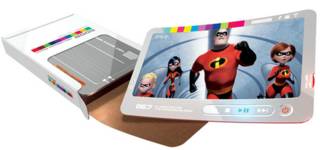
"MicroMedia Paper
This snapshot-sized display can play music, movies, and more
Price: $50 for a 10-pack
Designer: Lunar Design
Executive Summary: Wafer-thin display and storage finally brings digital media to the familiar format of paper
Tech Barriers: Flexible, disposable displays; radical new GUI; millimeter-thick batteries
Target Market: Photo-sharing families, 35 and up, plus execs wanting fancy business cards
Projected release: 2015"
--MobilePC via Gizmodo
(Can this be used as a product label or as a POP mini-display? Can it be networked?)
Previous posts:
E Ink: Digital Price Tags
E Ink: Digital POP Display
E Ink: Digital Billboards
Keywords: electronic paper, electronic ink, e-ink, e-paper
Closed Spaces: In-Flight Advertising

Emerging in-flight technologies:
- On-demand (CD-ROM) video entertainment enabling passengers to "order up" their choice of movies or other programming at any time (as opposed to directly-distributed programming, which provides a pre-established cycle/schedule of programs)
- Broadcast television/Direct television: live, real-time video broadcast feeds via satellite
- In-seat power outlets for notebook computer use
- Exterior-mounted video cameras displaying exterior flight view to passengers
- Intranet access (stored on server in cabin)
- Internet access (stored on WWW server)
- Incorporation of "Smart Card" technologies at the seat for payment services
More:
"Some airline passengers will soon find out as they pass their in-flight time playing popular video games, thanks to an alliance between Rockwell Collins and Nintendo. Rockwell Collins' in-flight entertainment system will offer a selection of more than 30 Nintendo Game Boy games on select twin-aisle aircraft."
--press release, July '04
" Currently, the Virgin's aircraft are outfitted with four different systems. The newest, V-Port, offers Video on Demand and will soon let you send & receive e-mails and surf the intranet. Some of Virgin’s 747-400 and A340 aircraft are equipped with Virgin Arcadia, an interactive entertainment system by Rockwell Collins."
-- press release, June '04
Also:
" Each month over 23 million passengers travel on airlines offering advertising-supported inflight television services. "
--Airline Advertising Bureau
"Melbourne-based company Inflight Advertising has secured an exclusive agreement with Freedom Air (a subsidiary of Air New Zealand) for sales and marketing rights to advertise on overhead lockers on Freedom aircraft."
--B&T, June '03
Also check an in-flight media directory at Business.com
Previous post:
Closed Spaces: Taxi
Round Up: In-Game Ads

Google just started beaming a text ad for inGamePartners through my site. What's more remarkable, it seems to be the first ad to promote services of "the #1 name in in-game advertising and marketing" (I feel guys at Massive Incorporated might disagree with the #1 claim, though). The larger image is inGame's implementation of a GE billboard within Counter Strike (view the larger original, see some more, compare to this in-game graffiti).
Update (several hrs later): Just spotted another Google ad, this time for Massive, that read: "The largest in-game advertising network to the gaming audience." It appears most often at this page, although you may have to F5 a couple of times. Is the war officially on? By the way, when you Google for "advertising in video games", one other company comes up on the right-hand side: Bidamic.
More:
"inGame's new advertising clients include Emerge Partners, which represents liquor brands Absolut, Remy Martin, and Jim Bean, Citrix Online, Electronic Arts, the United States National Guard, and "Lord of the Rings: the Battle for Middle Earth," through its game network partners. These partners include PHXX, GriffinRUN, and the Global Gaming League; inGame offers game network subscribers the option of linking to inGame's servers to play games for free in exchange for receiving digital ads."
--MediaPost, Oct.18, '04
"We can accept and convert virtually any image format, including PDF/PSD/TIFF/PNG/GIF/JPG/BMP. Frame-processed animation is also available as are custom ad sizes; the standard ad size are 256x144 pixels (IAB Standard Ad Sizes are also accepted on most of our network)."
--inGamePartners
"We can do anything for product placement. So say you’re playing Counter-Strike, which is the game we’re currently integrated into right now; let’s say you’re in Counter-Strike and you’re getting shot. And you’re losing health. So there could be generic water over there, or there could be this bottle over here [holds a bottle of Poland Spring]. The generic water is worth two points of health back, you take this [Poland Spring], and it’s another seven. So you get value added five extra points for drinking this. So it gets positive brand attributes and people associate this brand with better health. So we can do stuff like that."
--Darren Herman, inGame's CEO for InsideGamerOnline.com
"There will be an eerie sensation when a game player walks down a street and sees that same advertising campaign, say for a major motion picture that is starting its run next week, using the same artwork and delivery format as one he saw that evening in a game that he bought 3 months ago. Research says that it enriches the gaming experience and we can't see anything wrong with that observation."
--The Register, Dec.7, '04
"This study has provided some evidence that in the virtual world billboards for both high and low value products have a higher recall than in ‘real life’ situations such as sports events."
--Journal of Interactive Advertising, Fall '04
Previous posts:
Nielsen to Audit Game Ads
Use Of In-Game Ads Grows
Unexplored: Deus Ex Machinima
Advertising in Video Games: Problems
(Social) Advertising in Computer Games
Future: Product Placement
Tattoodvertise This

I guess this "full body tattoo shirt" from Sleeves Clothing leaves TatAd way behind in terms of potential impact.
Previous post:
Human Bodies As Billboards
Keywords: tattoos, advertising
Nielsen to Audit Game Ads

"Nielsen, which previously announced agreements with industry leader Activision, said it would also begin providing videogame advertising reports for the Massive Video Game Advertising Network beginning in the second quarter of 2005.
Massive utilizes an advertising network structure much like online ad networks, but guarantees delivery of advertising in the form of standard TV advertising units, either 15- or 30-second spots. Buys can be purchased across the network or a videogame segment specifically to reach specific consumer targets."
--MediaPost.com
Previous posts:
Use Of In-Game Ads Grows
Unexplored: Deus Ex Machinima
Advertising in Video Games: Problems
(Social) Advertising in Computer Games
Future: Product Placement
NintedoDS Adds Video, Music

"Nintendo Co. will begin selling an adaptor for its DS and Game Boy Advance handheld game players to allow them to play music and video, the company said, matching a popular feature on Sony's portable game machine."
--Reuters
Future: Searchable Video

Video Search Yahoo Com
More:
"Google, Microsoft and Yahoo are quietly developing new search tools for digital video, foreshadowing a high-stakes technology arms race in the battle for control of consumers' living rooms."
--ZDNet.com, Nov.30, '04
Previous posts:
Text Indexing of Video Footage
Future: Searchable Print Publications
Towards Clickable Print Publications
The Ultimate Lovemarks Inspire DIY Ads

As an advertiser, which would you prefer:
A) Real consumers who can't shut up about how much they love your product (i.e. bzzagents);
B) Consumers who create and distribute professional grade video ads for your product (like this one for iPod);
C) Consumers who gang up and pay for a two-page spread in The NY Times for your product (like the one above for the Firefox browser)
D) All of the above
(Update Dec. 23, '04: NY Times writes about how unauthorized DIY campaigns become a trend.)
More:
"For great brands to survive, they must create Loyalty Beyond Reason"
Kevin Roberts, Lovemarks
New Medium: Sony PlayStation Portable

How fast can you say "free 3d ad-sponsored games and videos for what is the season's hottest game console with a 4.5-inch, 16:9-format TFT LCD screen"? Here's the GameSpot's review of this piece of hardware. Here's what Sony PSP looks like from the inside.
Photo credit: lik-sang.com
Keywords: advertising, video games, sony playstation portable
Future: TV Over IP
"We live in the age of the digital packet. Documents, images, music, phone calls - all get chopped up, propelled through networks, and reassembled at the other end according to Internet protocol. So why not TV? The concept has profound implications for television and the Internet. TV over Internet protocol - IPTV - will transform couch-cruising into an on-demand experience."
--Wired
Future: Searchable Print Publications
--InternetNews.com
Towards Clickable Print Publications

"DuPont Registry, a magazine publisher of luxury classifieds, is replicating its monthly publications on the Internet to give readers the same experience online. Extending the magazines online in their original design also adds to their value as advertising vehicles. This is key for duPont Registry's titles since their content is 100 percent advertising and no editorial. Pages are geared to direct response."
--DMNews.com
More:
The New York Times Electronic Edition
iPodvertising Possibilities
--iMediaConnection.com
(Told you it was coming.)
Commentary: TiVo and Advertisers
DVR users' eagerness to skip commercials has led to more insidious forms of marketing, such as product placement within television shows. Those enormous cups of Coca-Cola on the judges' desk on "American Idol" were not there by accident. The relationship between TiVo and advertisers is also evident in TiVo's practice of selling information about subscribers to marketers. The company recently signed a deal with Nielsen Media Research to provide detailed (though not individually identifiable) information about customer viewing habits."
--LATimes.com
Commentary: Most Hated Ad Techniques
--Jacob Nielsen
New Genre: Mobi-Lit
--International Herald Tribune
Advertising Model: Pay-Per-Call
Here's the gist of how it works. An advertiser enrolls online, listing their phone number, description, market (e.g., city, miles from ZIP code, national), categories where the ad should appear, the bid price-per-call, and daily budget. Ingenio assigns a unique toll free number to each advertiser, and this number is displayed prominently in the paid search ad. Calls are forwarded to the advertiser's original number. The highest bid nets top placement in search results.
Ingenio is the pay-per-call company. Right now, they can rightfully be referred to as the pay-per-call company since it's the only known entity in the space. Ingenio isn't only a pay-per-call company - it's been in business since 1999 and has a number of other technology solutions, platforms, and services. According to Barach, pay-per-call is now the locomotive powering Ingenio, and everything else is along for the ride."
--SearchInsider
Ads Means Worms
"Hackers launched attacks on online banner advertisements last week with a range of worms based on My Doom and Bofra. The worms had propagated through several banner advertising companies, including Falk in Germany, which provides banner ads to a number of news and IT websites throughout Europe."
--ComputerWeekly.com
Previous:
Digital Billboards: Defacing
Networked Wearable Display

An update to an earlier round-up on Wearable Displays:
"The R&D division of France Telecom has developed a Bluetooth compatible LED screen that fits into clothing and displays text, drawings and animations sent by multimedia messaging service (MMS). The 4096 color LED screen comprises a flexible circuit board packaged in a fabric layered sandwich. Weighing 150 g (including battery) and measuring 10 x 7 cm, these displays are lighter, more colourful and easier to fit in clothing than the team's award winning fiber optic screens showcased at the Avantex textile trade show in 2002. The new removable screens insert into a special pocket in the garment and connect to a rechargeable battery with 4 hour charge life."
--Optics.org (plus more images)
--France Telecom's press release (plus a short demo movie).
Advertising on RSS
Table Advertising
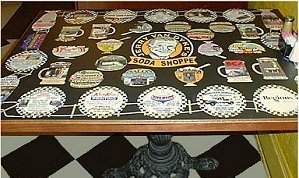
GEH & Associates sells advertising space to local companies, then imprints the ads in the laminate applied to the top of the tables, then gives the tables for free to the local restaurants. The venture is called TableAds.
More:
"America West launches tray table ads"
When air travelers flip down the tray tables on their America West Airlines flights, they'll be getting more than the usual peanuts or pretzels later this month. They'll also be getting advertising. America West executives said Tuesday that they have begun selling tray table advertising, and the idea is already taking off.
--SFGate.com
Use Of In-Game Ads Grows
--Forbes
Previous posts:
Advertising in Video Games: Problems
(Social) Advertising in Computer Games
Future: Product Placement
Unexplored: Deus Ex Machinima

While not technically new, the genre/medium of machinima remains largely unexplored (and underexploited), with a noteable exception of MTV's Video Mods show the channel uses to promote its music.
"The term 'machinima' concerns the rendering of computer-generated imagery with ordinary PCs and the 3D engines of video games (typically first person shooters) in real-time (on the computer of either the creator or the viewer) rather than offline with huge render farms."
--Wikipedia
The genre has been helped by the release of Electronic Art's "Sims 2" with a a built-in stream capturing feature. It is expected to be futher boosted by the upcoming The Movies game that will put players into a film director's shoes.
More:
An two-year old article by Wired gives a pretty good intro into the genre.
Machinima.com is an info portal on, well, machinima.
There's even a film festival run by Machinima Academy of Art's and Sciences.
Red vs. Blue is one of the more famous machinima series.
Previous posts:
Advertising in Computer Games: Problems
(Social) Advertising in Computer Games
Future: Product Placement
Marijuana on Target's Site for $25.25

UPDATE (Dec.13, '04): The marijuana page has been apparently removed from Target's site. You can still see the real-size screenshot by clicking on the image above. (Dec.20, '04) Substituted the original links to Target that were removed with cached ones from Yahoo.
Somewhat off-topic:Target organized what they called "the biggest wake-up call" to get customers into their post-Thanksgiving store. Apparenty, Target didn't want their customers to miss this great deal. Very appropriately, it's listed under "entertainment" (and here's some crack, too) .
Thanks to Neko at LiveJournal.
Keywords: target, marijuana, pot, spoof
Digital Billboards: Magink
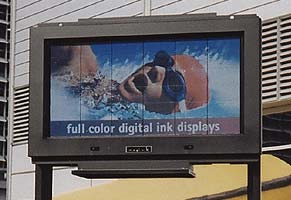
This comes as an update to yesterday's overview of digital billboards. Magink develops what they call "the first ever maintenance-free autonomous system operating in remote locations lacking adequate infrastructure".
"Magink's technology enables to create affordable "paper like" lightweight low power indoor and outdoor displays, which can perfectly fit into numerous applications. Its underlying properties fundamentally change the economics of digital content display."
From NYTimes.com:
"By creating a paste made of tiny helix-shaped particles that can be minutely manipulated with electric charges to reflect light in highly specific ways, Magink can produce surfaces that look like paper but behave like electronic screens, rendering high-resolution, full-color images without ink - or, as Magink executives like to refer to the process, with digital ink."
More:
Gyricon - producer of SmartPaper, which is "a reusable display material like paper, but is electronically writeable and erasable."
"How In-Store TVs Play to Shoppers" - a recent article on digital signage from Business Week.
Digital Billboards: Defacing

Adbusting follows the outdoor industry into the digital age. Not only can digital billboards be spray-painted, they can also get hacked.
More:
Just yesterday, a digital road sign was hacked in Florida.
Advertising in Video Games: Problems
Some of those problems might be solved when the next generation of consoles comes out, because they will have built-in Internet functionality, which brings with it the prospect of dynamic in-game ad serving. This capability, Madden said, could eventually lead to a more TV-like business model, where games are bought and sold on measurable cost-per-thousand impressions, without the hassle of months of planning. Madden said the industry is still four to six years from this becoming reality. The panelists agreed that in the short term, online gaming and advergaming remain the most cost- effective platforms for advertisers."
--Media Daily News
Previous posts:
(Social) Advertising in Computer Games
Future: Product Placement
Digital Billboards: Overview

(large image)
1. TOPPAN manufactures and markets segmented electronic paper display modules for use in public signs (more).
2. People at Vodafone claim their's is the only sign in the world that will display your personal message to a friend or loved one. Installed in London, Piccadilly Circus. See live cam of the billboard.
3. Coca-Cola's newly launched billboard in London is three times bigger than the previous Coca-Cola sign on the site, and comes equipped with the resolution of a cinema screen, computer technology, built-in cameras and even an on-board, heat sensitive weather station. The sign will be able to interact with people on the ground, recognising colour and movement in the crowd and will even be able to adopt it's messages according to the weather, with special sensors recognising rain, wind and heat. Watch video footage of the launch.
4. A Hypertag turns static poster sites and marketing displays into interactive ones. Consumers simply point and click their mobile phones at the poster or display which has been tagged to access content.
5. "The YellowArrow creates an interactive forum for people to leave and discover messages pointing out what counts" through unique identification based on mobile text messaging (see an earlier post).
6. Urban Display Network manages a network of outdoor LED screens wirelessly connected to the mainframe for real-time content update.
7. Ford launched a new ad campaign for the Ford Fiesta combining interactive billboards with SMS. Each passer-by can try their hand at winning a Ford Fiesta by sending an SMS with their first name to a short code and indicating the code on the billboard. The billboard then responds to this SMS, displaying a "good luck" message addressed to the person, and sends another SMS with a question that needs to be answered correctly.
E Ink: Digital Price Tags

"A new technology from Epson combines electronic paper by E Ink Corp with RFID tags to display the prices of products at stores. The small displays can show 8 bytes of character data." -- Gizmodo
More:
E Ink: Digital POP Display
E Ink: Digital Billboards
Advertising on Floors

In how many ways can you display your ad on a floor? The four most obvious ones (zoom in), left to right, are:
- Paint a graffiti (image from Graffiti Archive)
- Stick a laminated decal, such as this one from Maxx Graphics
- Install an IntelliMat - a wear-resistant, 3-foot by 4-foot screen raised only a half inch off the ground that delivers interactive multi-media, TV-quality advertisements.
- Install a wall-mounted projector from IBM paired with a camera designed to transform surfaces into projected "touch screens".
Stereoscopic Advertising, Part II

A Danish company ViZoo develop free-floating holograms, created by projecting an image onto a special see-through screen. The hologram merges with the foreground and background to create an illusion in a real-life setting. Pictured is a frame from their campaign for a Copenhagen's fashion boutique. See more.
In ViZoo's own words, "How people react when a young woman suddenly appears in the middle of a shop floor in a fashion boutique on Stroget (Copenhagen's main shopping street) and tries on clothes totally oblivious to her surroundings - and after closing time, too!"
More:
Stereoscopic Advertising, Part I
Keywords: stereoscopic advertising, 3d advertising, advertising holograms
Product Placements in Blogs
--InternetNews.com
Keywords: product placements, blogs
Text Indexing of Video Footage
We are capturing, indexing and keeping:
- One year archive of Network programming, Los Angeles market
- One year archive of CNN, Bloomberg Television, CNBC
- 2-6 month archive of cable news programing including CNNfn, Headline News and E! Television
- 2 month archive of New York, Chicago, and San Francisco markets
- 1 month archive of over 100 local markets nationwide
Special recordings dating back more than 5 years."
TiVo Ad Zapping is Good for Recall
--Media Daily News
Advertising Robots, Part II
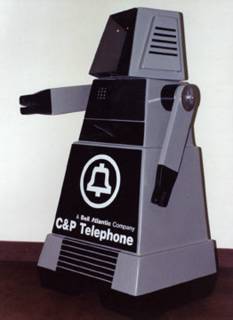
I am not making this up:
"Our robots have been used effectively in tradeshow exhibits, parades, fairs, carnivals, school functions, T.V. ads, grocery stores, real estate agencies, retail malls, gift shops, and auto dealer showrooms. In other words just about anywhere you may want to make a special and lasting impression on your customers.
Robot Factory - the original manufacturer of premium quality robots for advertising, promotion, education and entertainment - since 1966."
-- Robot Factory
More:
Buy a robot at the Robot Store
Advertising Robots

Put the latest achievement in artificial intelligence research to use and employ a chatting bot as your advertising agent. You can put one on your website or run it through an IM program or a chat invironment (such as IRC).
"Service Chat Bots provide some sort of service, whether that be customer service, product sales, site guides, information gathering, survey taking, or something else. These are generally more goal-oriented bots that may try to accomplish something with each chat, whether that be guiding someone through your web site, giving them information, selling items, or gathering information."
--Mondobot (pictured above)
"ALife-SmartBot Suite is a full fledged e-CRM solution It engages customers in the same conversational manner as would a human sales or support person. Throughout the discussion a customer can be guided, as well as consulted; consequently the smart bot can display the appropriate Web page, answer the questions, and even make specific recommendations."
--Artificial Life
More:
"As part of its continuous push to market its AOL Instant Messenger program, America Online is testing a new instant-chat robot that answers questions from AIM users about weather and stocks." -- CNET
"The Chatting AIM Bot is a bot that anyone can send upon their friends, family, co-workers, etc. using AOL Instant Messenger (AIM). The bot uses artificial intelligence to pretend to be a real person, tricking your friends into all kinds of hilarious conversations."
BotSpot.com - a comprehensive directory of available bots.
AI Research - an artificial intelligence research project that created one of the smarters chat bots to date.
Keywords: advertising robots, advertising bots, adbots, ad bots, chatterbots, chatbots, artificial intelligence advertising
Musical Greeting Cards
Here's a Google Answer on how musical cards work. Electronic123 sells DYI electronics kits. Chung Yen Products and Smartocean sell pre-made and custom-made cards (they also sell other cool stuff like flashing pins). Chrys's Corner sells regular musical cards with pre-recorded tunes (plus musical windmill and musical water globe).
Advertising on Money

Putting ads on money seems to be the quintessence of capitalism. It has been employed successfully by the state throughout history (commemorative coins) to drum up patriotism, now it has moved into the private sector. Here's what has been tried so far.
- Well, minting private commemorative coins (not for legal tender, though). The Highland Mint is one of the companies that offers the service. Northwest Territorial Mint is another.
- Squishing pennies (and quarters, nickels and dimes, too). You have seen those cool machines in the gift shops at historic locations and you can actually own one of them, from Copper Memories.
- Sticking your message onto dollar bills. First tried successfully last January by GoGorilla for USA Network's Traffic: Miniseries (pictured above, see CNN's article).
- Sticking your message onto coins. Tried last August by Crispin Porter Bogusky for Consumer Networks. "The quarters [would] turn up in Minneapolis vending machine change dispensers, pay phones and on the street" (PromoMagazine).
Closed Spaces: Taxi

"TouchTaxi, a media company based in Melbourne, kits out the cabs with heavy duty PCs in the boot connected wirelessly to large touch-sensitive screens in the back of the headrests, global positioning system (GPS) receivers, Wi-Fi wireless internet access cards and an SMS and general packet radio service (GPRS) data connection to the mobile phone network.
These parts work together to provide passengers with an in-taxi information system which they are free to browse while they are driven around the city. There's no need to ask the driver to recommend a bar or club in the area - the taxi itself is more than qualified to provide the answer. And because systems like these don't come cheaply, the top quarter of each touch screen is reserved for banner advertisements."
--BBC News
Stereoscopic Advertising

VRex 3d Stereoscopic Solutions provide just that - stereoscopic solutions. They have some really bright ideas, such as doing an IMAX-like stereo presentation or making company's brochureware in 3d, anaglyph glasses included. A 3d billboard sounds interesting, too.
More:
Attend a conference on Stereoscopic Displays and Applications XVI (2005), January 17-19, 2005.
See Actuality Systems' gallery of truly 3d, although not yet big enough, displays.
Keywords: stereoscopic advertising, 3d advertising
Applian Records Streaming Video

Applian's new Replay Video Suite (featuring WM Recorder) is software that allows for one-click capture and multiple simultaneous recording of multiple video streams, including music videos, music, news feeds, subscription content or any other streaming media content in Windows Media or Real Media formats.
Context Ads in Newspapers
TiVo To Insert Ads Into FastForward
"By March, TiVo viewers will see "billboards," or small logos, popping up over TV commercials as they fast-forward through them, offering contest entries, giveaways or links to other ads. If a viewer "opts in" to the ad, their contact information will be downloaded to that advertiser — exclusively and by permission only — so even more direct marketing can take place."
--LA Times
More:
- Bill may ban zapping (Wired)
- Slashdot comments.
Keywords: tivo, pvr advertising, interactive advertising, future of pvr
Podcasting: Advertising on iPod

New craze: podcasting. Listeners pull digital audio files from websites down to computers and devices where the audio can be played back at a listener's convenience. Audio includes not only MP3 music, but also talk shows, personal audio diaries and more. It can include advertising, too. Plus Apple recently announced the release of iPod Photo.
More:
Everything you need to know about podcasting from Wikipedia and ITWorld.
Jeff Jarvis's take on how podcasting may change the future of advertising.
Keywords: podcasting, iPod, advertising, digital audio, time delay
E Ink: Librie E-Book Reader

Librie, a new version of e-book hardware from Sony (EBR-1000 Librie eBook reader, in Japanese). On sale in Japan only since April until they figure out how to curb potential file sharing. For now, only a limited library of mostly public domain books is available. Size: 126 x 190 x 13 mm, weight 190 g. See a product review.
More:
Older Gemstar e-book devices.
Keywords: digital advertising, digital books, digital newspapers
Human Bodies As Billboards
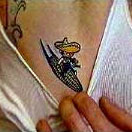
For some reason it's the buzz of the day without being a new or a groundbreaking concept. A company called TatAd sells advertising space for corporate logos tattooed onto human bodies. But then, you already can Headvertise (or rather could, since apparently the operations are down) and Assvertise.
More:
"Forehead advertising goes extreme with Toyota"
E Ink: Digital POP Displays

"Ink-In-Motion is a flashing electronic display that gives advertisers the proven promotional sales lift of motion displays in a paper-thin package. Because a typical Ink-In-Motion display can animate continuously for up to 6 months using just two AA batteries, these displays are ideal for high-impact POP signs in retail environments where power plug access is often limited. In addition to long battery life, these displays can be easily viewed from all angles and under virtually any lighting condition."
-- E Ink press release
-- Midori Mark Co, maker of Ink-in-Motion
Keywords: digital advertising technology, electronic ink, POP/POS displays
E Ink: Digital Signage & Billboards

"E Ink Corporation, developer and marketer of electronic paper display technology and TOPPAN Printing announced an agreement for TOPPAN to manufacture and market segmented electronic paper display modules for use in public signs. Under the terms of the agreement, TOPPAN will utilize E Ink® Imaging Film products in the manufacture and assembly of these display modules."
-- E Ink press release
Keywords: digital advertising technology, electronic ink, billboards, displays
Wearable Displays II

"Chibi Vision, a U.S.-patented (US 6393745) brand new advertisement method, is a digital walking billboard that you can fashionably wear as a backpack. Ad video contents run on a 7-inch digital screen. You can make a cool video in any form."
-- Universal Planners
Keywords: portable video, displays, walking billboard, ambient advertising
Interactive Wallpaper

"The surface of the wallpaper can display text and images according to the input received from a computer. The wallpaper works like a low resolution and low refresh rate display, giving you the possibility to change patterns and contents on your walls. By Dario Buzzini."
-- Interaction Ivrea
Wearable Displays

"Los Angeles based Nyx clothing is launching a range of customised jackets with built-in flexible display screens that connect to a Palm OS PDA or smartphone such as the Treo or Kyocera, and can display the message of your choice on your clothes.
The illuminated jackets run on three NiMH rechargeable AA batteries and last for 8 hours (Duracells last for twice that long). The current jacket has a 16x16 pixel display screen on the front (7.5cm x 7.5cm) and a 16x32 pixel display screen on the back (15cm x 31cm). The upper limit for wearable displays currently set in software is 100,000 of the larger panels, enough to cover a football field and all the people in the stands."
--Gizmag
More:
"Billboards" that walk, talk, and even flirt a little - eleven-inch, flat television screens adorn the fronts of T-shirts worn by winsome women.
-- CS Monitor article
-- Tshirt TV
-- Brand Marketers, the company behind the idea.
(Social) Advertising in Video Games

"Velvet-Strike is an online protest modification that players can use to subvert the normally violent Counter-Strike game. Velvet-Strike replaces bullet-ridden body counts with peaceful protests, spray-painted anti-war messages and civil disobedience."
-Wired
More:
"Massive Incorporated: Creator of the world's first video game advertising network. It dynamically serves advertising across a network of premier video game titles and return measured results on consumer interaction with this brand messaging. "
"Nielsen Entertainment Media announced in April that it was working with Activision, Inc. to develop a tracking technology that would monitor how many in-game advertisements a user encounters and when."
-MSNBC
"Advertisers will triple spending on video game ads by 2008. New figures from the Yankee Group claim the U.S. video games industry reaches more than 108 million gamers 13 years of age and older, who will have spent $7.4 billion by the end of the year."
- MediaDailyNews
Typology of *blogs
- Weblog (blog) - a journal available on the web. Caslon and Soggy give good outlines of different type of content found on blogs.
- Photoblog: something is a photoblog if it has photos, it's on the web, and it is a log of some sort (photoblogs).
- Moblog: a 'mobile blog' or 'photo journal' comprised of camera phone pictures that are posted direct to the internet from your mobile phone (mobog, textamerica, busythumbs).
- Audioblog: a service that provides bloggers with the ability to post audio to their blogs from any phone (audblog, audioblogger).
- Videoblog: the latest add-on allowing to place streaming video on blogs. Not sure how it is better or different from webcams (see discussion on slashdot).
Branding Food

"In January of 2002 Rich had a simple, but exceptionally clever idea: Embossing foods with messages and images. The objective is to enhance the dining experience while providing a unique and effective means to enhance corporate marketing campaigns. " Gourmet Impressions LLC was born.
Future: Marketing "To One"
-An older article from ACNielsen on alternative advertising vehicles.
More:
"Provided economic growth can be sustained, ad spending may continue to pick up. How will the money be spent? There are plenty of alternatives to straightforward advertising, including a myriad of marketing and communications services, some of which are called “below-the-line” advertising."
- Economist, June 2004, "Harder hard sell."
Future: Product Placement

Paul Christ at KnowThis.com writes: "The visual and audio product placements seen so far may only be the tip of the iceberg with regard to product placement opportunities. One can see the day when product placement invades other sensory areas such as smell, touch and, possibly, taste. "
Pictured: a branded Mitsubishi car in the latest "Need For Speed: Undeground 2" computer game by Electronic Arts.
More:
Nielsen Entertainment and Activision, which partnered this year to develop tools for measuring the effectiveness of product placement in video games, have enlisted automaker Chrysler Group to help test its methodology.
--Reuters
The Decade of Ad Banners

This is the first banner ad that appeared ten years ago in October 1994 at Hotwired.com. It was not animated. It linked to the AT&T website.
More:
Banner Ad Museum
Banner Report

